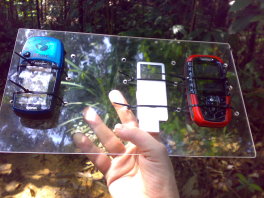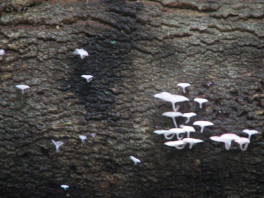Rojak 10, Presentation, Singapore 2007.
December 1st. During the 10th rojak event in singapore, syntfarm gave a presentation about their journeys and explorations in nature. rojak 10, a quarterly held art & design sharing session, was a special edition focusing on collaborations during the singapore design festival 2007. during the presentation, syntfarm gave an insight into the derivation and motivation of their work and the processes behind their performances.
Prague soil, Installation. Prague 2007.
Strelecky island
50,04'51.14"
14,24'36.38"
Holeckova ulice
palyground
50,04'24.93"
14,23'29.40"
Stadion Strahov
50,04'48.38"
14,23'02.30"
Vitezne namesti
parking
50,06'04.41"
14,23'45.45"
Olsanske graveyard
50,04'42.45"
14,27'46.35"
Narodni muzeum
50,04'42.86"
14,25'51.24"
frantiskanska zahrada
park in the center of the city
50,04'54.86"
14,25'26.06"
During the 3rd international festival for arts, sciences and technologies enter3 in Prague, we installed a soil moisture sensor which was connected to the visualization interface written in processing. 7 soil samples were taken from different locations in Prague, and were referenced with their GPS coordinates.
The soil moisture sensor was displayed as one of the interfaces we added to an assortment of our performance instruments.
Together with the sensor and 7 petri-dish that included Prague Soil samples, there was a video that documents our previous explorations.
Excerpt
In 1974, French biologist Francois Jacob, published a text titled "Le Modele Linguistique en Biologie" In Critique, no. 322, where he stated: "Genetic material has two roles: it must be reproduced in order to be transmitted to the following generation, and it must be expressed in order for it to determine the organism's structures and functions." listen and watch.
syntfarm did one ad hoc installation-performance whereby all the
instruments used and data gathered from the group's trips were
presented in a gallery space. The audience walked through the
installation, which was also a performance stage, and browsed through
the notebooks from their trips, checking out syntfarm's official
clothing, their instruments that they use for performances, and
interacting with the whole system. This event helped artists to start
thinking about a very specific role and participation of the audience
and their education with the use of interfaces like soil quality
sensors, water pollution instruments, air pollution detection
instruments as new interfaces for their future installation-
performances.
The idea for the performance was to relive and express the moments and discoveries during the reef-walk at kusu. a new sound engine was written in java, which was combined with the previous drum machine software. one projection consisted of photographs which were tagged by their locations and time (the information about where and when the pictures were taken were also displayed in sync with the photos on the screen) following the video documentation of the life forms. next to this was a projection of our journal and various synthetic forms which revealed some of the discoveries from the intertidal landscape. Image by emma ota, more image are archived in the dislocate flickr group
On july 27th 2007, we walked on the fuji mountain. we arrived at 1:20pm local time and started on 2300m above sea level. air is thin and sharp. the soil is volcanic. we are walking on the inner parts of the earth's gut that erupted in 1708 during the edo period. there are several layers in its strata. new fuji is believed to be formed around 10,000 years ago on top of the old fuji which dates around 100,000 years. also, its basalt layer is about several hundred thousand years old and when you walk on this active strato-volcano, you constantly feel, inhale, and are aware of fuji's dust and it is a bit hard to breathe. the wind is making it cold. mist. we are in the cloud almost non stop. then, it's gone. sunshine and the wind. rocks are slippery.
our first task was to create a system that would be able to store data, enable its tactile use, and share the performances for other people's reinterpretations and uses. at this stage, we have a digital instrument which enables us to perform and interpret levels of the complexity and infinite layering of impulses from the forest.
our first task was to create a system that would be able to store data, enable its tactile use, and share the performances for other people's reinterpretations and uses. at this stage, we have a digital instrument which enables us to perform and interpret levels of the complexity and infinite layering of impulses from the forest.























